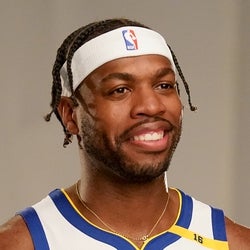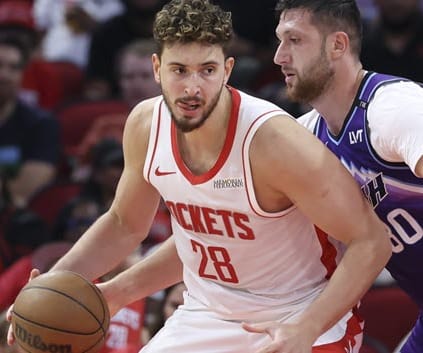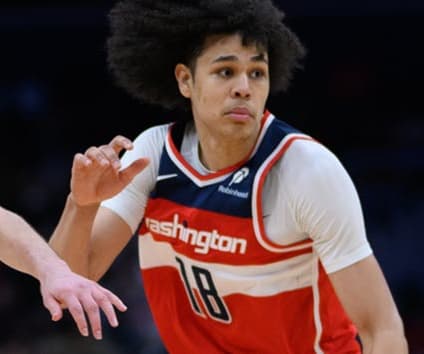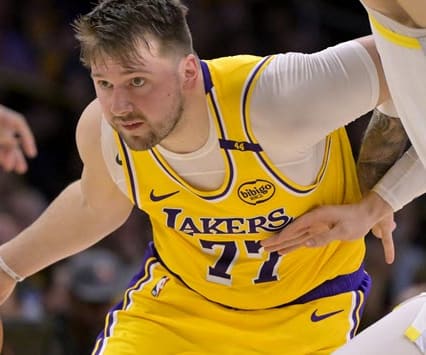2025 Stats
PTS
8.0
REB
2.6
AST
1.6
STL
0.9
BLK
0.1
ROS Projections
2025 Fantasy Outlook
Hield's first season in Golden State was filled with ups and downs, as he struggled to find consistency on a nightly basis. He was always available, though, as he appeared in all 82 regular-season contests with averages of 11.1 points, 3.2 rebounds, 1.6 assists, 0.8 steals and 2.5 three-pointers in 22.7 minutes per game. That was his lowest workload since his rookie campaign, and it was just enough for him to crack the top-200 players in standard nine-category leagues on a per-game basis. As for 2025-26, things in Golden State don't look much different from how they ended last season. Jimmy Butler will begin what will be his first full season with the team, and the club signed Jonathan Kuminga to an extension at the beginning of training camp. To Hield's credit, he stepped up in the postseason, averaging 12.5 points while hitting 42.5 percent from beyond the arc in 27 minutes per contest. He has a wide path to minutes on this team with minutes at shooting guard and small forward, and as long as his workload is stable, he'll be a steady source of three-pointers. The rest of his stat profile is pretty underwhelming, however. Read Past Outlooks
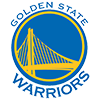
Back to second unit
Hield will come off the bench Sunday against Portland, Danny Emerman of SFStandard.com reports.
ANALYSIS
Golden State's lineups continue to be fluid, and this time it's Hield and Pat Spencer who will move to the second unit. Hield is coming off a pair of duds with an average of 7.5 points over his last two outings.
Golden State's lineups continue to be fluid, and this time it's Hield and Pat Spencer who will move to the second unit. Hield is coming off a pair of duds with an average of 7.5 points over his last two outings.
NBA Per Game Stats
Per Game
Total
Per 36
NBA Per Game Stats
Loading Per Game Stats...
2025 NBA Game Log
2025
2024
2023
2022
2021
2020
2019
2018
2017
2016
2025 NBA Per Game Split Stats
Schedule
By Month
Starting/Off Bench
Days Rest
Vs Opp
By Result
2025 NBA Per Game Split Stats
Loading Split Stats...
Advanced Stats
Loading Advanced Stats...
Stat Review
2025
2024
2023
2022
2021
2020
2019
2018
2017
2016
How does Buddy Hield compare to other players?
This section compares his stats with all players from the previous three seasons (minimum 200 minutes played)*. The bar represents the player's percentile rank. For example, if the bar is halfway across, then the player falls into the 50th percentile for that stat and it would be considered average.
True Shooting %
53.7%
Effective Field Goal %
51.5%
3-Point Attempt Rate
65.5%
Free Throw Rate
9.3%
Offensive Rebound %
4.1%
Defensive Rebound %
10.7%
Total Rebound %
7.4%
Assist %
13.0%
Steal %
1.9%
Block %
0.4%
Turnover %
10.5%
Usage %
19.2%
Fantasy Points Per Game
15.3
Fantasy Points Per Minute
0.8
NBA Historical Fantasy Stats
Historical ADP
Loading Historical ADP...
Warriors Depth Chart
Our full team depth charts are reserved for RotoWire subscribers.
Subscribe Now
Warriors Rotation: Minutes Breakdown
Loading Warriors Rotation Data...
Average Fantasy Points
Minutes
FanDuel
DraftKings
Yahoo
FantasyDraft
Head2Head
Sorare
Average Fantasy Points are determined when Buddy Hield was active vs. non-active during the season. Click here to view average fantasy points for a different time period.
Loading Average Minutes...
Past Fantasy Outlooks
2024
2023
2022
2021
2020
2019
2018
2017
2016
Hield joined the Warriors this offseason and will play for his fourth team over the last four years. It all came crashing down last season for the sharpshooter in Philadelphia, who had the worst year of his career, averaging 12.1 points, 3.2 rebounds, 2.8 assists, 0.8 steals, 0.5 blocks and 2.6 threes per game. What's discouraging is that Buddy played just 25.7 minutes while taking 10.1 shots per game. Those are massive drop-offs from what we've seen in past years, with Hield averaging 31.8 minutes and 14.7 shots across the previous five years. It's unclear what sort of role he'll play for his new team, but Golden State parted ways with Klay Thompson, opening up the door for Hield to fill a major role. The only problem is that the Warriors have developed into one of the deepest teams in the league, with Brandin Podziemski, De'Anthony Melton, Kyle Anderson, Jonathan Kuminga and Andrew Wiggins all occupying minutes at the wing positions. That doesn't even take into consideration Stephen Curry and Draymond Green, so it wouldn't be surprising to see Hield limited to 25 minutes again. A bounce-back season could be in the cards, but there are just too many bodies to see Hield return to the stud we saw before last season.
More Fantasy News

Draws start Saturday
Hield will start Saturday's game against the Cavaliers, Anthony Slater of ESPN.com reports.
ANALYSIS
Subscribe now to instantly reveal our take on this news.
Subscribe now to instantly reveal our take on this news.

Adds 14 points off bench
Hield closed Thursday's 99-98 loss to the 76ers with 14 points (6-12 FG, 2-7 3Pt), eight rebounds, two assists, one block and two steals in 26 minutes.
ANALYSIS
Subscribe now to instantly reveal our take on this news.
Subscribe now to instantly reveal our take on this news.

Inefficient 13 points Tuesday
Hield recorded 13 points (4-15 FG, 2-9 3Pt, 3-3 FT), one rebound, four assists and two steals over 28 minutes during Tuesday's 124-112 loss to the Thunder.
ANALYSIS
Subscribe now to instantly reveal our take on this news.
Subscribe now to instantly reveal our take on this news.

Drops season-high 20 against Utah
Hield supplied 20 points (8-13 FG, 4-8 3Pt), five rebounds, four assists and one steal in 23 minutes off the bench during Monday's 134-117 win over the Jazz.
ANALYSIS
Subscribe now to instantly reveal our take on this news.
Subscribe now to instantly reveal our take on this news.

Woeful season continues
Hield ended Friday's 127-123 loss to the Trail Blazers with zero points (0-1 FG, 0-1 3Pt), one rebound and one steal in 16 minutes.
ANALYSIS
Subscribe now to instantly reveal our take on this news.
Subscribe now to instantly reveal our take on this news.
Latest Fantasy Rumors

Warriors want to keep him around
The Kings aren't interested in including Hield in any potential deal with the Kings for Jonathan Kuminga, according to Sam Amick of The Athletic.
ANALYSIS
Hield has been mentioned as a potential secondary piece of a deal that would send Kuminga to Sacramento, but the Warriors are looking to avoid that scenario at all costs. They value Hield due to his elite outside shooting, and they aren't interested in letting him return to Sacramento. It's worth noting that Hield had the best years of his career with the Kings, including a 2018-19 campaign in which he averaged 20.7 points over 82 regular-season contests.
Hield has been mentioned as a potential secondary piece of a deal that would send Kuminga to Sacramento, but the Warriors are looking to avoid that scenario at all costs. They value Hield due to his elite outside shooting, and they aren't interested in letting him return to Sacramento. It's worth noting that Hield had the best years of his career with the Kings, including a 2018-19 campaign in which he averaged 20.7 points over 82 regular-season contests.


